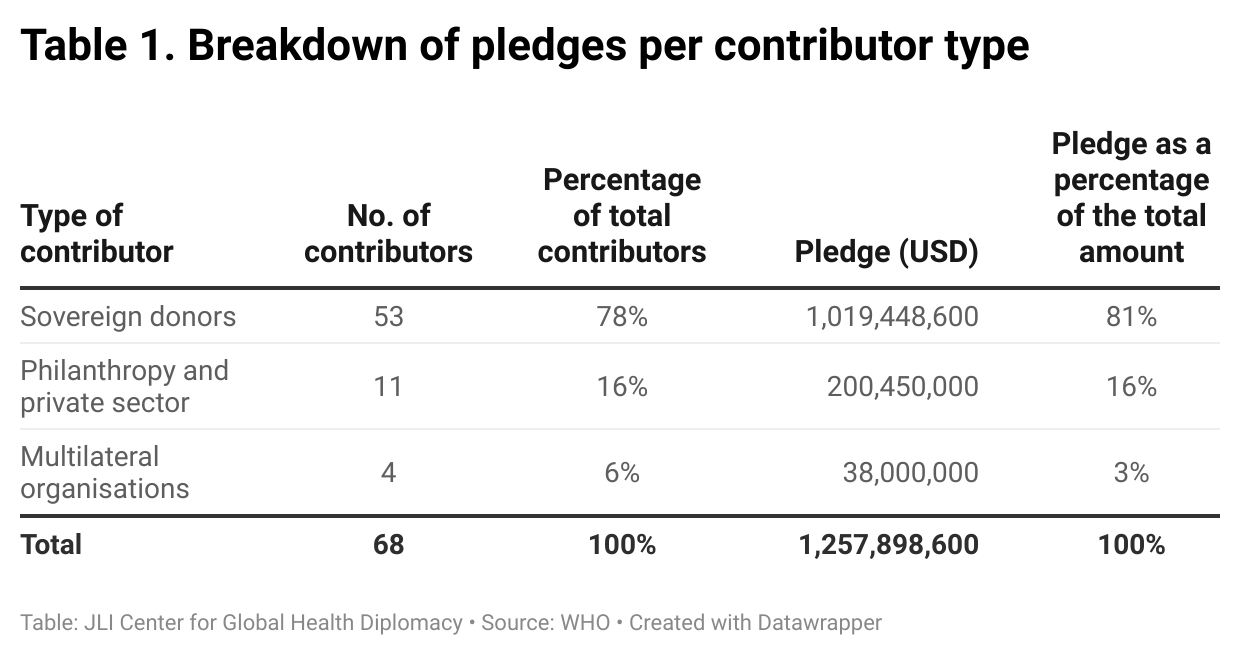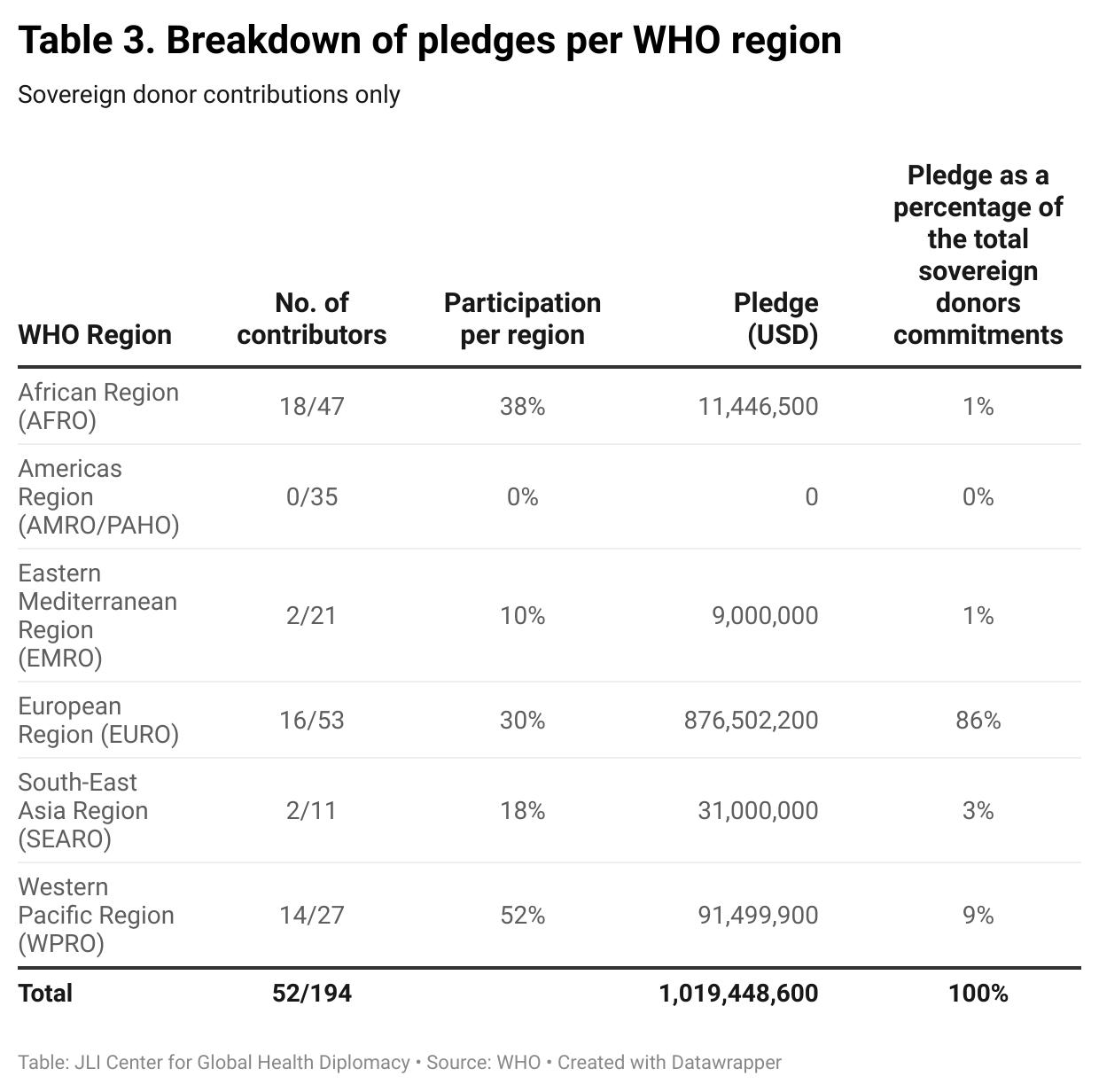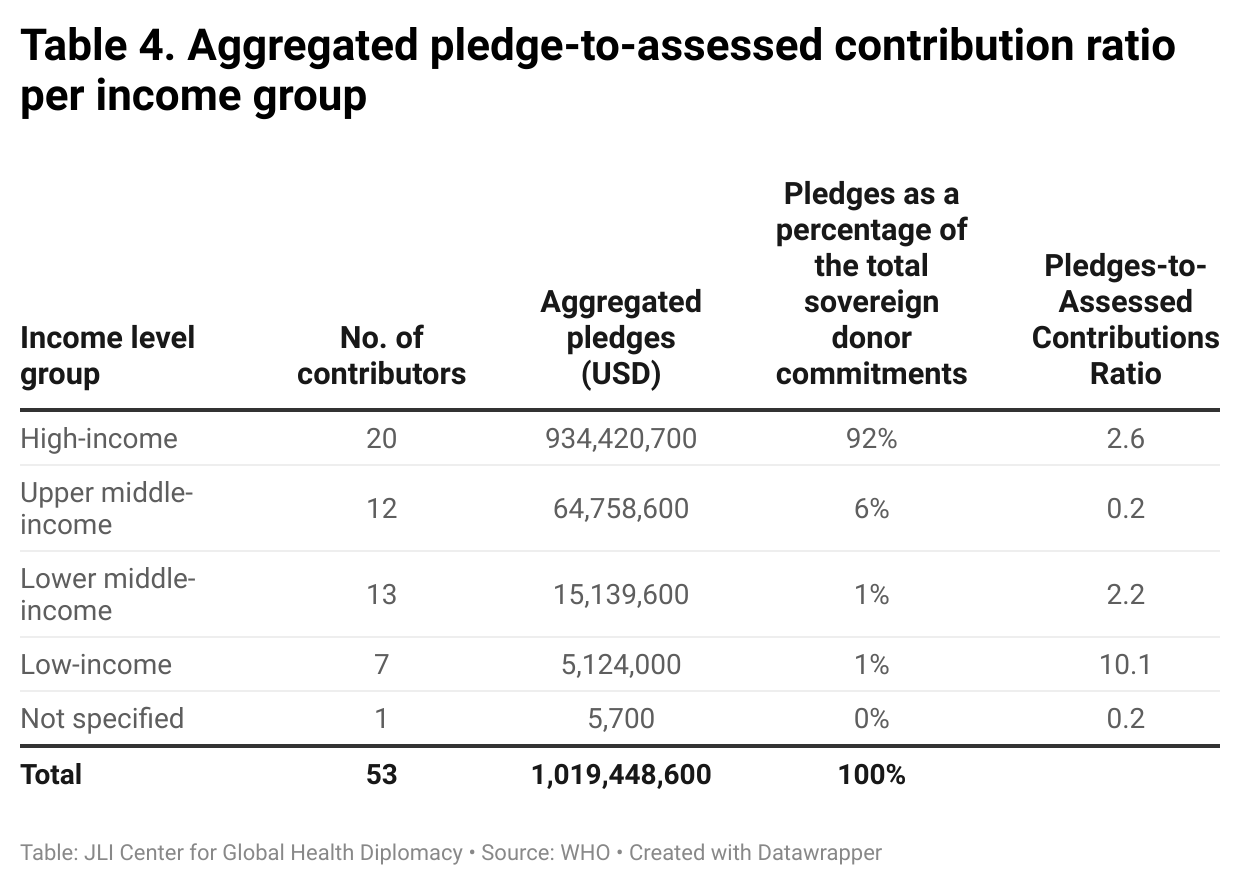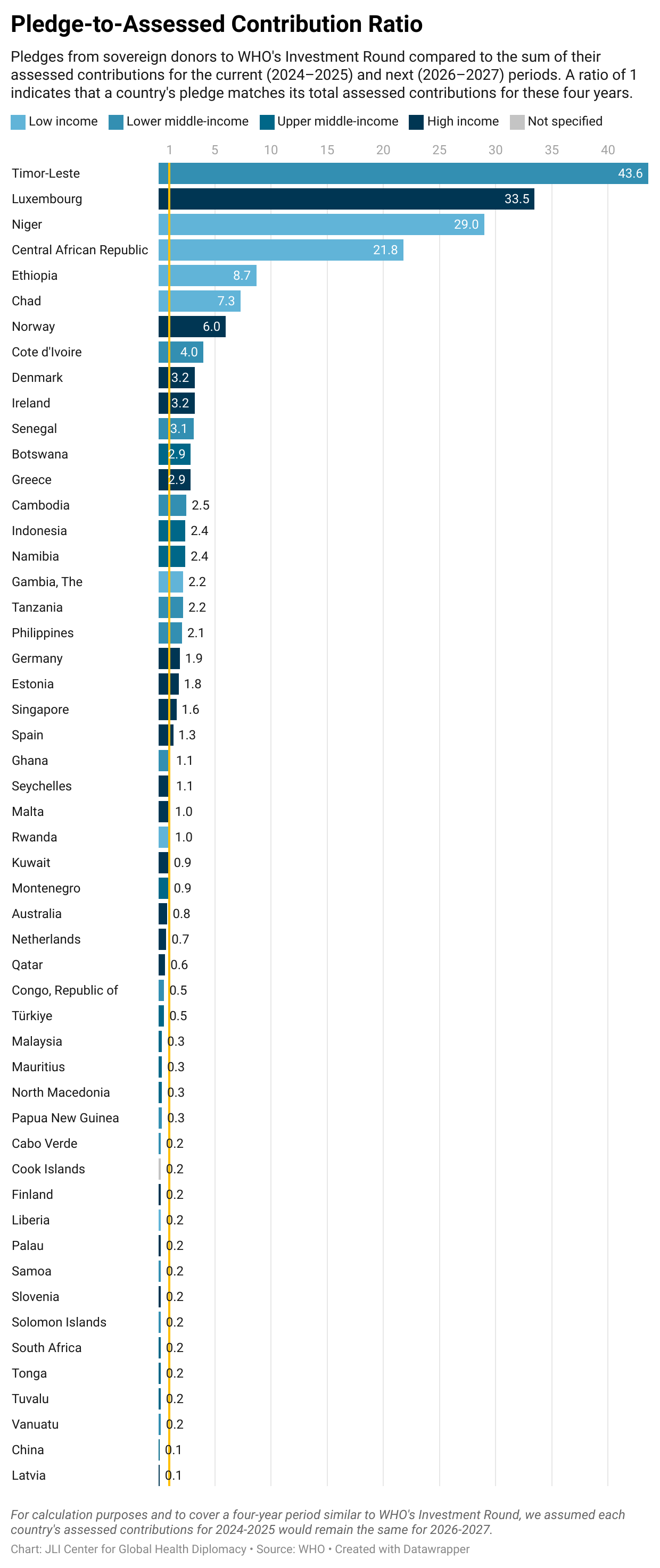Culmination of the WHO Investment Round at the G20: Significant Step Towards Sustainable and Predictable Funding for WHO
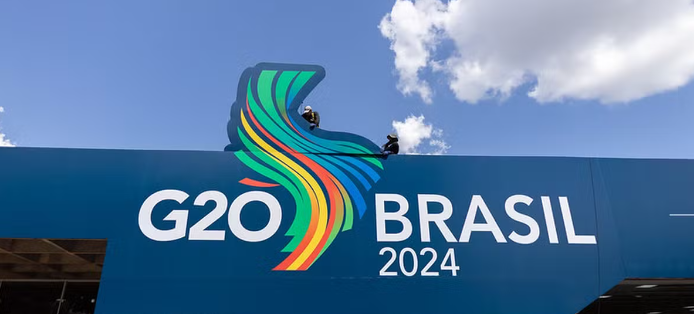
In this guest contribution, Rafael García and Christoph Benn from the JLI Center for Global Health Diplomacy analyze the preliminary results of the World Health Organization’s first-ever Investment Round (IR), unveiled at the G20 Summit in Rio de Janeiro. Read the full report here.
November 2024 / Rio de Janeiro / Article by Rafael García and Christoph Benn
On November 19 at the conclusion of the G20 Summit in Rio de Janeiro, the World Health Organization announced the preliminary outcome of its first-ever Investment Round (IR) — a new approach to mobilise “predictable and flexible resources” for its core work over the next four years (2025-2028). Brazilian President Lula da Silva and WHO Director-General Dr. Tedros could report on a total of US$3.8 billion in financial commitments, funding agreements and partnerships, covering 53% of the IR’s US$7.1 billion funding target. This is a significant achievement in contrast to 2020 when initially WHO had only 17% of funding secured at the beginning of its previous strategy. Germany has strongly supported the process by co-chairing the IR together with Brazil, France, African Union, Kingdom of Saudi Arabia, Norway, Indonesia and the Republic of South Africa making its pledge at the World Health Summit in Berlin.
Although leaders still have time in the coming months and years to make pledges and further strengthen WHO’s finances, the significance of the current commitments goes beyond the headline figures. A deeper analysis reveals notable results and offers key insights into the success of future resource mobilisation efforts in 2025 and the advancement of new, sustainable funding models for WHO and other global health initiatives.
WHO’s IR high-level figures
The following analysis is based on publicly available WHO’s commitments data as shown on Nov. 19, 2024 (22h45 CET).
The IR attracted new commitments from 70 donors totalling US$1.7 billion (two are not included in the available data). Out of the 68 disclosed pledges, 53 were sovereign donors (78% of disclosed contributors), 11 were philanthropy and private sector entities (16%), and 4 were multilateral organisations (6%).
In terms of the disclosed pledged amounts — almost US$1.26 billion —, sovereign donors committed US$1.02 billion equalling 81% of the total. Philanthropies and the private sector contributed US$200.5 million (16%), and multilateral entities pledged US$38 million (3%).
Sovereign donors’ pledges under the microscope
A closer look at sovereign donors shows remarkable results. To start, from WHO’s 194 Member States, 52 countries made pledges, representing 27% of its membership. By region, Africa had the highest number of contributing countries (18), while Europe pledged the largest amount. The highest participation per region was observed in the Western Pacific Region (WPRO), with 14 of its 27 countries (52% of the region’s members).
When it comes to leading economies, seven members of the G20 matched their stated commitments to global health and WHO with a pledge: Australia, China, Germany, Indonesia, South Africa, Türkiye, and the European Union. Out of the 38 members of the OECD — which represent about 60% of the world’s GDP — 14 (37% of its members) pledged: Australia, Denmark, Estonia, Finland, Germany, Greece, Ireland, Latvia, Luxembourg, Netherlands, Norway, Slovenia, Spain, and Türkiye.
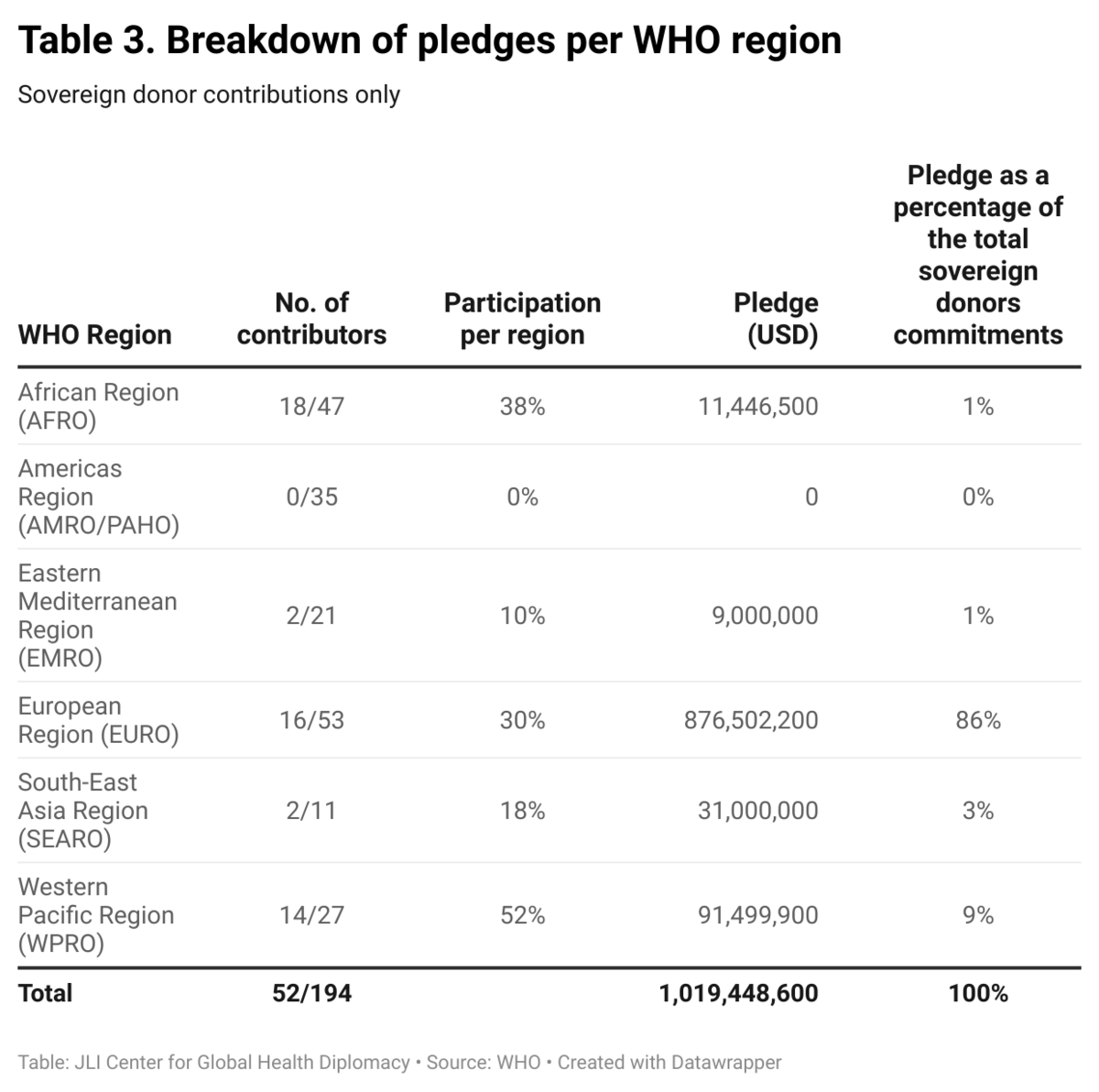
WHO also reported that 39 countries pledged additional financial support beyond their assessed contributions for the first time, a remarkable achievement. Moreover, it is crucial to evaluate all pledges not only in absolute terms but also in relation to WHO’s assessed contributions, which are calculated using a fair-share formula. This formula considers factors such as national wealth and debt, reflecting each country’s overall capacity to contribute to global health efforts.
From this perspective, while low-income countries’ pledges accounted for only 1% of the total, they were equivalent to 10.1 times their combined assessed contributions. In contrast, high-income sovereign donors contributed 92% of the total, though these represented 2.6 times their aggregated assessed contributions.
Notably, 27 countries committed amounts exceeding at least double their assessed contributions for the 2024–2027 period, demonstrating their prioritisation of support to WHO. Particularly remarkable were the commitments from Timor Leste, Luxembourg, and Niger, which pledged 43.6, 33.5, and 29 times their assessed contributions, respectively.

Finally, compared with the Global Fund’s last replenishment—another crucial global health initiative—WHO’s IR had a similar number of sovereign donors. In 2022, 51 countries and the European Union committed to contributing to the Global Fund, while 52 countries and the European Union pledged financial support for WHO’s IR for now.
Given that this pledging moment was the first after the US election and in a context of significant cuts in several major donor countries to their international cooperation budgets, it is worth to analyse the outcome of the WHO in more detail and look for lessons learned for other upcoming resource mobilization campaigns in health and other sectors.
Five takeaways for WHO and global health and development financing
- Bringing on board non-traditional donor countries is crucial. WHO's Investment Round (IR) has been a successful resource mobilisation effort, engaging a broad donor base beyond the traditional high-income countries that typically provide official development assistance. In this round, 52 countries, representing 27% of WHO's membership and spanning five of its six regions, pledged financial contributions. There are specific reasons why the commitments from the PAHO regions are considered differently.
- Size matters, but not only in absolute terms. While most pledged funds (92%) come from high-income countries, it’s commendable that many low- and middle-income countries (LMICs) have more than doubled their assessed contributions. Their pledges highlight the value these countries place on supporting WHO and practising global solidarity, indicating a growing willingness to explore more ambitious international cooperation and financing models.
- Reinforcing health as a global public good. There is widespread agreement among WHO members that healthy societies are essential for global security and stability. However, there remains a need to strengthen the case for equitable contributions to health as a global public good and to bolster global solidarity—especially from the major economies.
- Sustainability remains an open challenge. While the IR marks a pioneering step towards the sustainable and predictable funding of WHO, efforts must continue to fill the remaining gap and appeal to member states who have yet to announce their commitments beyond the assessed contributions.
- A commitment to explore a Global Public Investment model. WHO is already a step ahead in moving towards a model in which all member states contribute based on their capacities. WHO’s assessed contributions formula aligns with GPI principles (all countries contribute, all countries benefit, all countries decide) by defining each country’s fair share. With the IR results, WHO now has a solid foundation for further exploration of models and complementary formulas that could enhance governance, improve financial predictability, and support a sustainable, fair and equitable financing structure that addresses remaining gaps and benefits all countries and people — All for Health, Health for All.
Acknowledgements: The authors thank Nana Nyama Danso for her support in elaborating on this analysis. One of the authors (CB) is a member of the advisory board (Lenkungskreis) of the Global Health Hub Germany.
Image: Divulgacao
Tables: Rafael García and Christoph Benn
We have invited Rafael García and Christoph Benn to share their report for our website. The article is written from theirviewpoint and invites readers to gain insights into the recent WHO Investment Round.

